Simplicity Coimbatore ,Wild tapioca chips
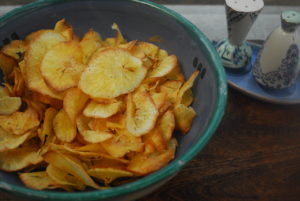
The crisp ,golden edges of the piping hot ,(home-made) tapioca chips was just what the appetite ordered during the monsoons.This tea-time treat that happened to coincide perfectly with the afternoon rain ,hit all the right flavour notes on the taste buds.

The maravalli kizhanghu or tapioca is a plant which can be spotted growing wild just about anywhere, is what the farmers here in Coimbatore showed me. These plants can be found in a grassy patch ,at the edge of a culvert,in an open field… (if you take the time to look). It’s just that we are little educated about how to identify these edible plants. In fact the first time I saw it I thought it was a castor plant ! When we hear of foraged food, we think of country greens, medicinal herbs and maybe the odd rain fed mushroom.
Folks living abroad celebrate, wild berries, tubers, greens etc, in fact there are farmer’s markets which celebrate all sorts of wild produce. That’s what crossed my mind when we spotted a large thicket of maravalli kizhanghu happily thriving in the middle of a cultivated vegetable patch. How great it would be if this kind of produce was identified, understood,celebrated and also sold commercially . It takes almost 9 months to reach maturity. That’s also why the shops selling chips here in the city don’t have regular stock of the tapioca chips.
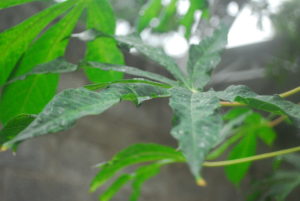
The plant grows tall and thin like a reed and sprouts large serrated leaves which fan out like the palm of the hand when opened.A little bit of the soil is cleared to see how well the tubers have grown before it is fully dug out. Having identified the plant by the leaves,we soon spotted some growing in and around the neighbourhood. There’s one growing now close to our front gate.
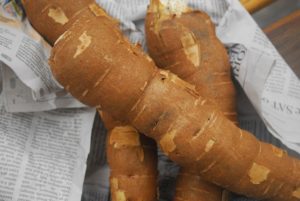
The benefits of eating wild produce has to do with the fact that it grows as nature intended it to without any human interference. There was so much excitement surrounding the tapioca harvest.The air was buzzing with recipe ideas. There were talks of roasting ,of making a tapioca mash and everyone’s favourite, the tapioca chips.
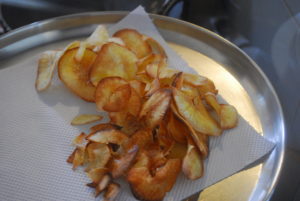
The method for making chips is pretty straightforward. After removing the tough outer skin,the tapioca root needs to be sliced using a mandolin vegetable cutter because it’s difficult to get thin slices using a hand held knife.One needs to be careful even with the slicer ,trust me, I have a nick on the edge of my forefinger which was quite painful ! Next the slices must be soaked in water to get rid of the excess starch , dried thoroughly on paper before being dunked in hot oil.
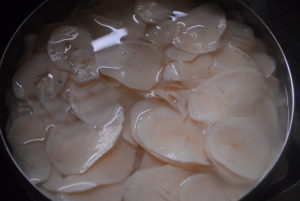
Surprisingly, the most laborious part of making these tapioca chips was that of getting the excess water out. Thankfully we had a whole bunch of clean newspapers to absorb all that water. A damp slice will lead to a soggy chip and we don’t want that at all.

Other than the tapioca pearls (jowarisi),this ingredient in it’s fresh form is rather under-utilised around here. Cooked tapioca has the right texture for making cutlets or vadai and is a great mash variation instead of a potato.
A back water ride in Kerala is the place to try steaming hot kappa (tapioca) with fish.Today most hotels and restaurants in God’s own country have this native ingredient on their menu.It is believed that the Portuguese carried this tuber from Brazil and distributed it all through Asia. The story goes that the King of Travancore was responsible for making this ingredient popular among the people.It was offered as an alternative to rice when the area was facing a drought. This reference dates back to between the 17th and 18th century.
The root is also referred to as Cassava in Brazil where it is known to have it’s origins. It cannot be consumed when raw as it is said to be highly poisonous. Hence the need to peel , wash and cook thoroughly before eating.
The tapioca mash is light , delicious and can be flavoured with both sweet and savoury seasonings. A simple tempering of curry leaves, mustard seeds, dried red chillies and small onions in virgin coconut oil is very tasty when added to the cooked and mashed tapioca. Some of the tubers have a bit of excess fibre which needs to be removed while mashing. A little bit of warm milk makes the mash creamier in texture.It can be served with crackers or grilled meats.

We gave the red chilli powder a miss and added black pepper instead to our in house chip experiment.The inherent sweetness of the tapioca is so unique and complements the bits of powdered sea salt beautifully. With the oil at the right temperature,the chips turned out thin ,crunchy and not in the least bit greasy.
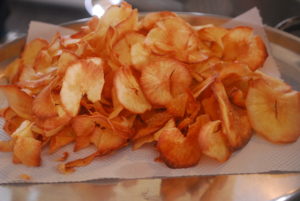
Yet another joyous day spent in the kitchen with the October showers adding to the happy vibes !
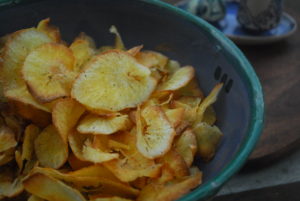

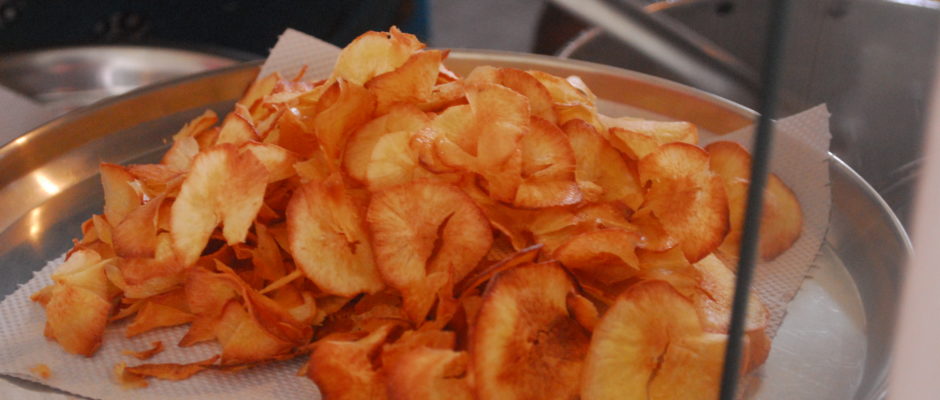
No comments yet.